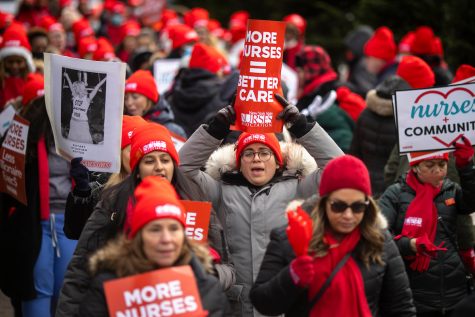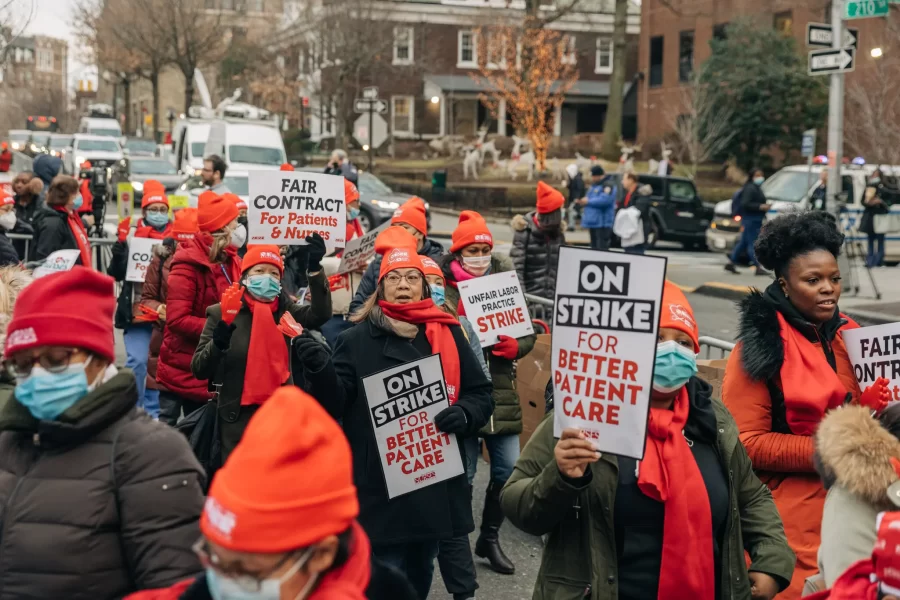New York Nurses Fight For Better Working Conditions
More than 7,000 nurses at New York City hospitals went on strike to fight for better wages and working conditions.
PHOTO | Jeenah Moon | The New York Times
New York City nurses gather outside of Montefiore Medical Center to fight for better working conditions for the benefit of themselves and their patients.
Nearly three years ago, New York City nurses were on the front lines fighting the battle against the COVID-19 pandemic as it ravaged the concrete jungle. On Monday Jan. 9th nurses stepped up to the battle lines once again; this time fighting for themselves.
Following a meeting with the Mount Sinai Hospital management Monday morning, more than 7,000 nurses, members of the New York State Nurses Association (NYSNA), went on strike throughout New York City calling for better wages and safer working conditions. Nurses and their supporters lined Madison Avenue outside of Mount Sinai Hospital and the three campuses of Montefiore Medical Center in the Bronx.
The largest strike the city has seen in decades isn’t the first instance in which nurses protested the unsafe working conditions by striking. On Sept. 15, 2022 nurses at the University of Chicago Medical Center took action to protest routine understaffing. On Dec. 15, 2022 nurses in the United Kingdom protested underfunding and demanded better wages and working conditions.
Hospitals across the nation are experiencing a shortage of nurses due to extreme burnout following the COVID-19 pandemic leading to severe understaffing of hospitals. A study by Health Affairs estimated that in 2021 alone, the United States lost 100,000 nurses. The lack of nurses in hospitals has created unsafe working conditions for not only nurses and other healthcare workers, but also for patients.
Emergency room nurses at Mount Sinai are managing up to 18 patients at any given time. Patients at Montefiore Medical Center are being kept in hallways so frequently that the hospital has installed televisions to monitor them.

“It’s unsafe because, in the emergency room, how can a nurse safely monitor 20 patients?” nurse practitioner Johnaira Dilone-Florian said in an interview with the The New York Times. “Anything can go wrong. We are human, we’re not machines.”
Between the two hospital systems, there are between 500-700 unfilled nursing positions; a problem that expands state wide due to hospitals’ lack of zeal to hire staff. In New York state, a new law requires hospitals and other care facilities to maintain staff ratios that are safe to workers and their patients. However, this law hasn’t been enforced due to the pandemic.
“The patient-to-nurse ratios are unsafe,” New York City nurse John Adriel said in an interview with The New York Times. “Every time I go into work, truly I’m scared for my license.”
An agreement between Mount Sinai and Montefiore and their nursing staff early Thursday morning, bringing an end to the three day strike. Montefiore’s tentative deal includes a 19.1% wage increase over the next three years and creating 170 new nursing positions within its hospital system. Mount Sinai’s tentative deal also outlines these same promises. Both Mount Sinai and Montefiore have said they are happy with the agreements reached between the NYSNA and themselves in separate statements.
Nurses at Montefiore Weiler walking back to work this morning! pic.twitter.com/rmCDHNNPa2
— NYSNA (@nynurses) January 12, 2023
“It is fair and responsible, and it puts patients first,” Mount Sinai said in a statement.
The nurses are set to vote on whether or not to ratify the tentative deals with both hospital systems. Deals, similar to the ones tentatively made with NYSNA and Mount Sinai and Montefiore, were made with NYSNA and eight other New York City hospitals prior to the strike.
“When you become a patient in a New York hospital, you should have enough nurses to care for you, no matter who you are,” president of NYSNA Nancy Hagans said in an interview with The New York Times. “Nursing has to become a sustainable profession that keeps us at the bedside, now and for the future generation of nurses that we need to build up.”



